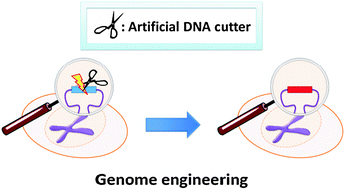This tutorial review provides recent developments in artificial cutters for site-selective scission of DNA with the focus on chemistry-based DNA cutters. They are useful tools for molecular biology and biotechnology, since their site-selectivity of scission is much higher than that of naturally occurring restriction enzymes and also their scission site is freely chosen. In order to prepare these cutters, a DNA-cutting molecule is combined with a sequence-recognizing molecule in a covalent or non-covalent way. At targeted sites in single-stranded and double-stranded DNAs, the scission occurs via either oxidative cleavage of nucleotides or hydrolysis of phosphodiester linkages. Among many successful examples, an artificial restriction DNA cutter, prepared from Ce(IV)/EDTA and pseudo-complementary peptide nucleic acid, hydrolyzed double-stranded DNA at the target site. The scission site and scission specificity are determined simply in terms of the Watson–Crick rule so that even the whole genome of human beings was selectively cut at one predetermined site. Consistently, homologous recombination in human cells was successfully promoted by this tool. For the purpose of comparison, protein-based DNA cutters (e.g., zinc finger nucleases) are also briefly described. The potential applications of these cutters and their future aspects are discussed.

You have access to this article
 Please wait while we load your content...
Something went wrong. Try again?
Please wait while we load your content...
Something went wrong. Try again?


 Please wait while we load your content...
Please wait while we load your content...